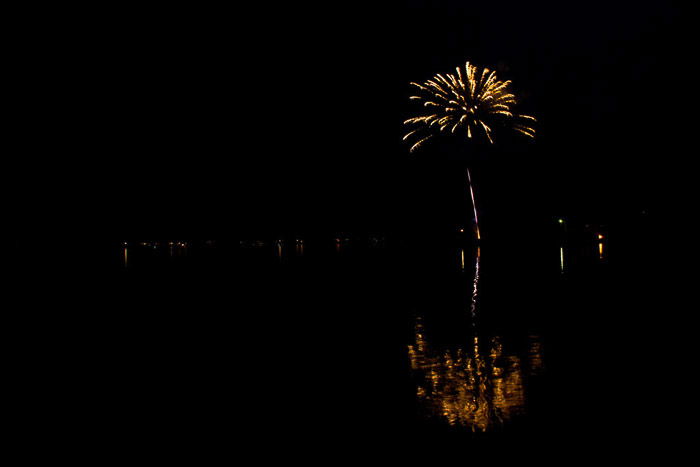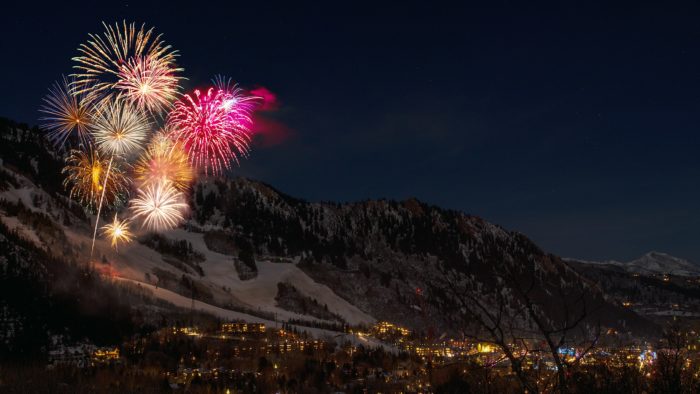How to Photograph Fireworks for Impressive Photos (5 Steps)
Firework photography isn’t easy to master, and it often results in blurry shots and inaccurate exposures.
So how do photographers snap those amazing fireworks photographs you see on social media? With the right gear, the proper settings, a few shooting tricks, and some patience. Let’s begin!
This guide on how to photograph fireworks will help you take your images from ordinary to awesome.
[highlight type=”short” price=”no” tag=”epshorthighlight-20″ toc=”no” title=”Sigma 24-105mm f/4.0 Art DG OS HSM” badge=”Versatile Focal Length” product=”25372″]Capture stunning photos of fireworks with ease by using a high-quality lens. Get stable and fine image quality from wide to mid-telephoto range, and enjoy the combination of fixed aperture and a good zoom ratio. Tips included.[/highlight]
Photograph Fireworks: Scout the Location in Advance to Find the Best Spot
The first thing is to plan and know when and where the fireworks are taking place—the Fourth of July and New Years of the most popular events.
Unfortunately, air pollution or cloudy weather can stand in the way of contrasty images. Get to know the forecast with the Dark Sky app and use Google Maps to locate and scout your venue in advance.
Identify where the fireworks will be launching from. It is useful to understand the distance and direction of where the fireworks will be coming from.
Plan to arrive like an hour before the fireworks start. Spend that extra time while there’s a little bit of daylight for better visibility if possible.
Look for neat features that will add interest to the scene. These could include a reflection on water or fireworks over a cityscape. Foreground elements such as trees or people will become silhouetted and can add scale to your photographs.
These are all things that will strengthen the composition. It would help if you also looked out for potential pitfalls. These would be power lines in the way or trees too tall, that obstruct the view.
You can also use this time to set your camera settings and adjust your tripod.
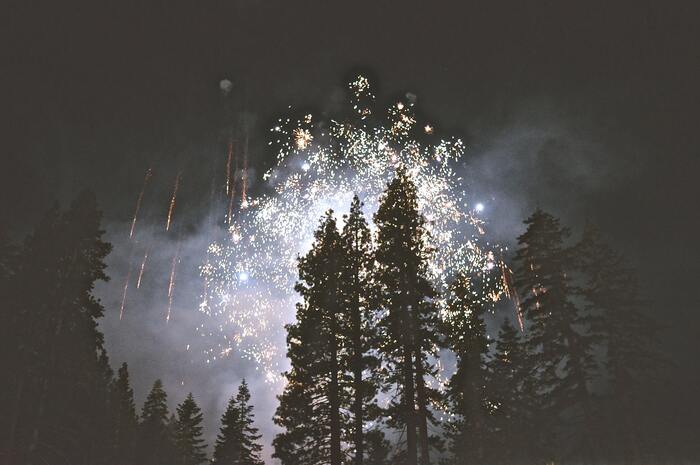
What Photography Gear To Use
What’s Important When Choosing a Camera
You are probably not going to buy a new camera just for photographing fireworks displays. But some features are beneficial to have for fireworks photographs.
The best is if you have a DSLR camera or a mirrorless one with manual mode because it is advantageous to have full control over your settings.
As fireworks happen in the evening or at night, you will need a camera with great low-light performance. Fireworks themselves are bright, but a huge part of your image will be dark. It’s even better if your model features an ISO invariant sensor.
As you will need to edit your pictures, image quality and resolution are crucial factors. Full frame cameras usually perform better on this task than cameras with crop sensors.
A remote shooting mode is also appreciated.
It’s useful to have a mirror lockup option if you are using a DSLR. Its job is to reduce the vibration inside the camera body by flipping the mirror up in advance. So the vibration happens before the shutter opens without affecting your shots.
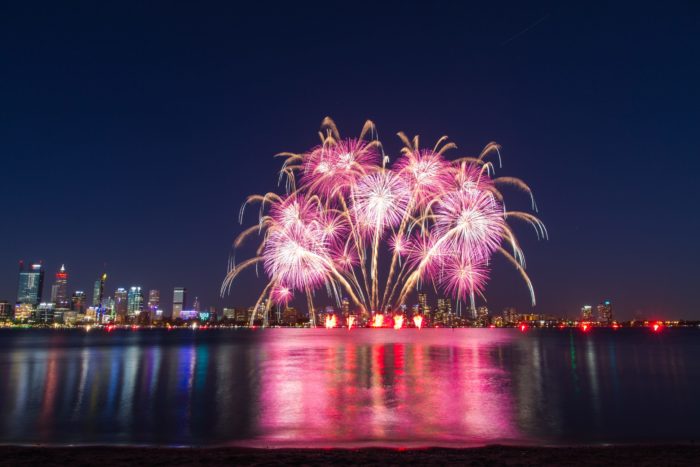
What Kind of Lens to Use
Another important part of the equipment of a photographer is, of course, the lens.
Use a zoom lens if you want to have a versatile tool. It will allow you to shoot from a distance and include, for example, a cityscape in the foreground. But also, you can take closer photos of just the firework itself by zooming in. Travel zooms such as the 24-105mm are a good option.
You can use prime lenses too, of course. You will have to choose in advance what kind of composition you are aiming for. A 35mm wide-angle lens is ideal if you want more of the background and foreground.
A telephoto lens is more for capturing the exploding fireworks, without their surroundings. We advise you to stay in the 70-200mm range.
Why You Should Use a Tripod
Stabilizing the camera is an absolute must here, especially if you want to capture an environment under the fireworks shots.
Fireworks photography is an extension of the long exposure technique. Without a tripod, you’re going to end up with blur. For best results, it’s necessary to minimise camera shake.
You don’t need the most expensive tripod out there. Look for something sturdy enough to hold your camera sturdily.
But if you don’t have one, how do you take pictures of fireworks without a tripod? In that case, find a steady location where you can place your camera so it can sit still for long exposures. This can be, for example, a table, wall or roof of your car.
Once you’ve found your desired composition, set up the tripod for that view.
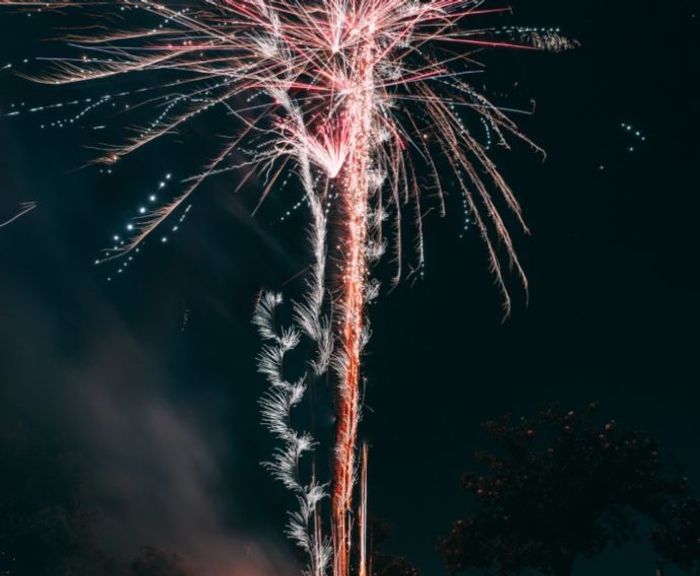
What Kind of Accessories You Might Need
There is a high chance that you are going to stay outside for a long time. Depending on your location, the weather can be cold if you choose to shoot fireworks on New Year’s Eve. So it’s wise to take extra batteries with you, as cold temperatures reduce battery life.
A fast SD card is also useful as you might want to shoot frames continuously. It takes time to process the images as you should shoot in RAW so a fast card will keep the camera shooting.
If you have a remote shutter release, make sure to use it for shooting. Many newer cameras have Wi-Fi, which also allows you to use your smartphone as a release. This way you can minimise camera shake, which is even more important when you are using a slow shutter speed.
If you don’t have a remote release or Wi-Fi, using the self-timer is also a good idea. But your chances of capturing a great moment are decreasing this way dramatically.
Not the first thing you would use as an accessory for digital photography, but you could take a folding chair with you. You will thank yourself when you are standing in your chosen spot, waiting for the firework to start.
A flashlight is also going to be a great companion. Unless you can adjust your camera settings in complete darkness, bring one along.
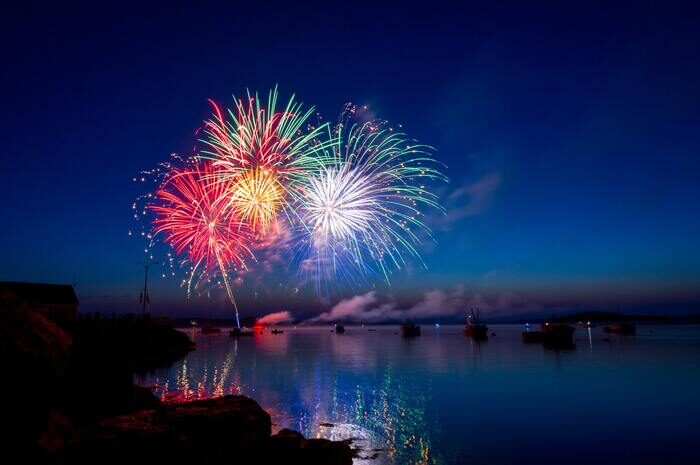
How to Set Your Camera
Which Camera Mode to Choose
It would be best if you chose Manual Mode to have full control over your settings.
While photographing in manual mode is best, some point-and-shoot cameras even have a fireworks mode. If you don’t have manual modes, try shooting in the fireworks scene mode. You’ll still need a tripod, but you won’t need to set the exposure and focus manually.
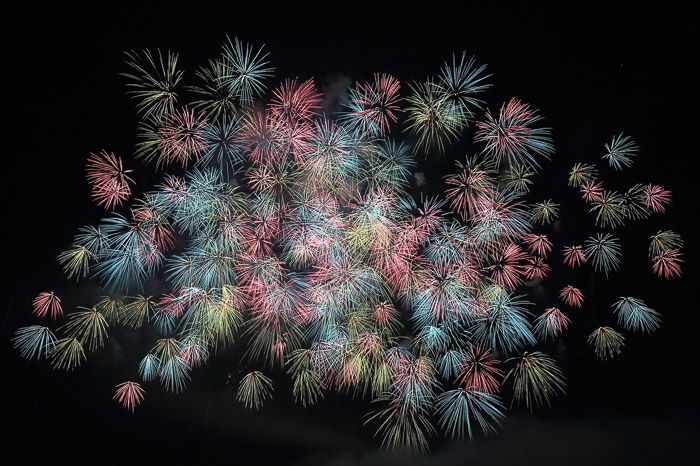
In case you’re using a DSLR or mirrorless in manual mode, experiment with the exposure triangle before the photoshoot. This way you’ll be ready for the long exposure firework photography.
Why Shoot in RAW
You should shoot fireworks in RAW, as a huge part of your frame will be dark.
You might want to bring out details from the darker areas, like buildings in the foreground. This can be done better with a RAW image.
Altering the white balance also can be done without quality loss if you have a RAW file.
How to Set Your Aperture
The exact exposure values are going to vary. This is based on whether there are any other lights in the scene and how many fireworks are going off at once.
Start with an aperture of f/11. As you shoot, check your exposure and adjust as needed. Choose a larger f-number (a smaller opening) if the shots are too bright.
If the fireworks show starts at dusk, you may lose some light. You’ll need to brighten up your aperture to account for the low-light. Choose a smaller f-number (a wider aperture) if the shots are too dark.
Usually, you are going to get the best results with an aperture between f/5.6 and f/11.
The smaller the aperture, the most likely diffraction is going to occur. Usually, it happens above f/11.
This is because light has to go through a small hole, and light rays will interfere. Due to this, your images are becoming less sharp as this phenomenon blurs small details in your images.
To photograph fireworks, you usually need a deeper depth of field. The background is not going to be visibly blurry, as it’s dark. To keep the fireworks display in focus, make sure not to set a too wide aperture.
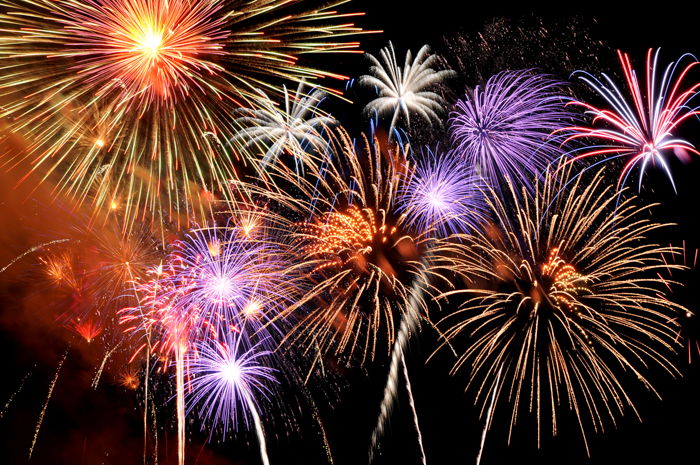
What Shutter Speed to Use
Some fireworks are quick bursts. Others maintain an impressive streak across the sky for several seconds.
You would have to set your shutter to at least 1/20. Try shooting when many fireworks are bursting in quick succession. This will increase the chances of getting a good shot.
The trick to getting the firework’s entire movement across the sky is to set your camera to Bulb Mode.
In Bulb Mode, you control the shutter speeds by holding down the shutter release. The camera continues recording until you let go of that button. The ‘Bulb’ setting makes it possible to shoot fireworks without knowing how long that next burst will last.
To use ‘Bulb’ Mode, turn your camera to manual mode. Turn the value all the way down until you see B or Bulb near the shutter speed display.
The unique exposure time is great for long exposures, but it works just as well with one quick fireworks burst.
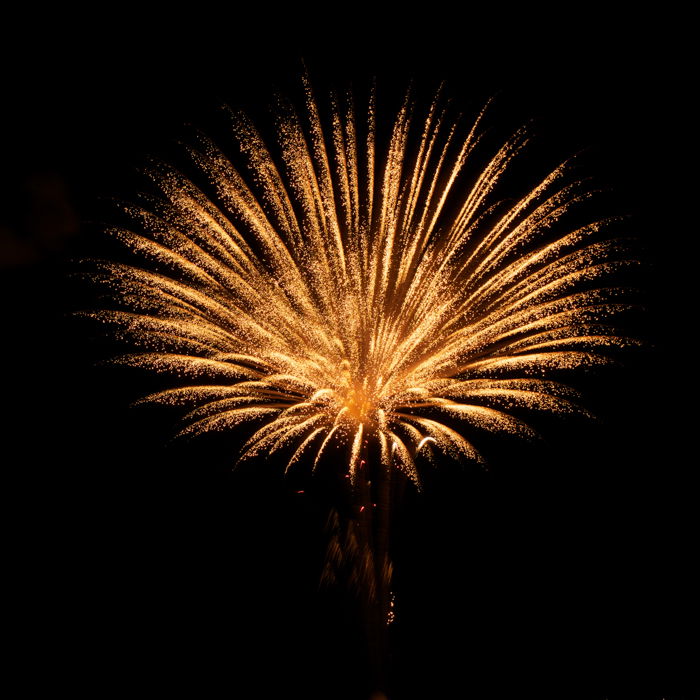
How to Set Your ISO
As fireworks are bright and you will use a long shutter speed, you will need a low ISO.
This is the reason why – although you are photographing at night – you won’t need a strong noise reduction during post-processing.
Set your ISO to the lowest value available on your camera, like to 100 or 200.
If you are operating with a faster shutter, you can go higher. But your maximum ISO shouldn’t be higher than 3200 with a full frame camera, or 800 with a crop sensor.
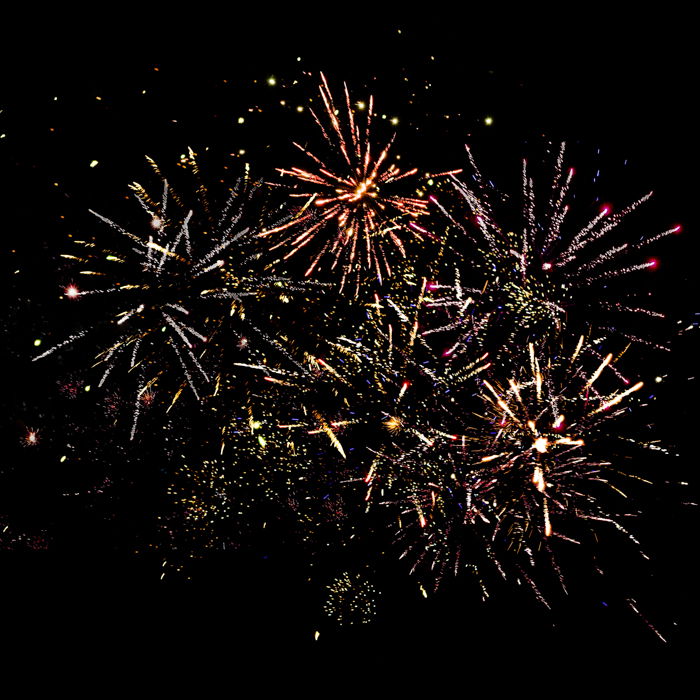
Why Choose Manual Focus
Your camera can’t focus on the dark. And they can’t focus on a firework that hasn’t exploded yet. This is why you definitely should use manual focus.
Adjust the focus dial on your lens to focus a tiny bit closer than infinity.
Since fireworks are far away and you are going to have a high depth of field, for most situations this technique works well.
But it would help if you previewed your first shot and zoom in to check focus. If the fireworks are a bit soft, you may need to pull the focus further back.
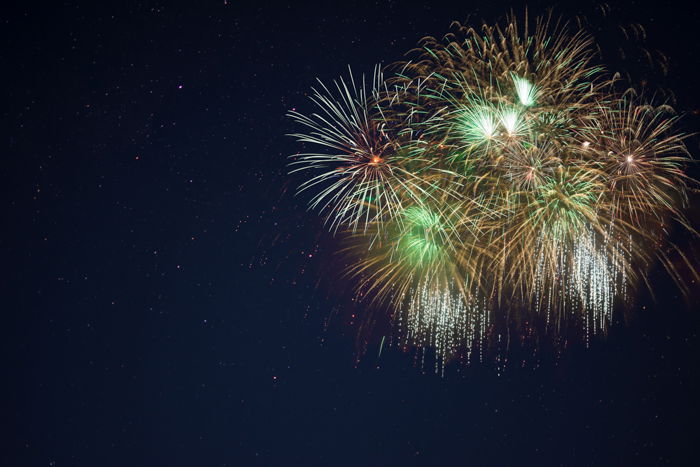
How to Vary Your Composition
You won’t be able to plan your compositions completely as you can’t predict the exact spots where fireworks will appear in the sky.
But there are some photography tips on composition that can help you get closer to the photos you imagined.
You can vary the angle you are photographing fireworks from.
If you stand close to where the fireworks are shot from, you can photograph them from below. This is going to result in frames filled by the fireworks.
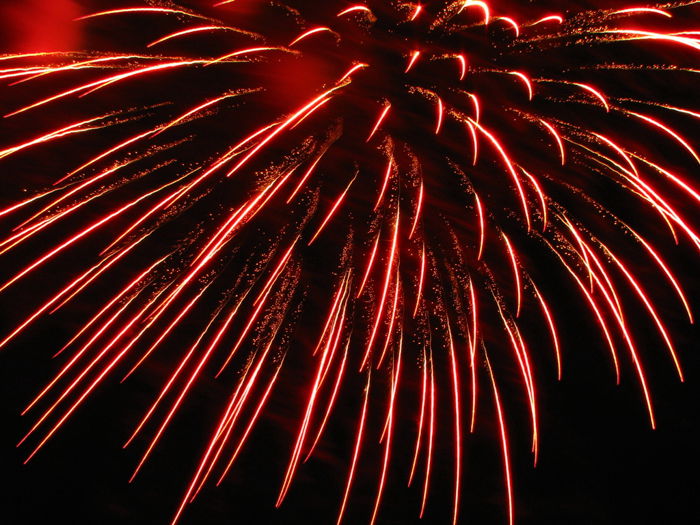
If you are shooting from a distance, you can include more fireworks in your frame. This way, you can vary your composition.
This is where juxtaposition can come in. To get a good image, you can include other elements in your foreground. This can make a nice contrast between different textures and subjects.
If you are standing in a crowd, you can use the people standing near you to create amazing silhouettes. At first, you might think about them as distractions, but don’t be afraid to use them as parts of your composition.
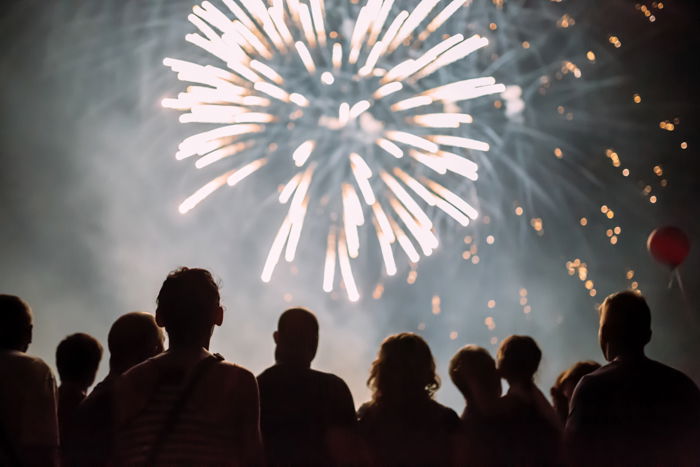
Also, try using the rule of thirds. In short, this means that your subject shouldn’t be in the middle of your image.
It would help if you observed first, where they are shooting the fireworks from. When you find where they are coming from, try composing that spot to the third of your image. Of course, a lot depends on how high they are going. But you can adjust your vantage point to place the fireworks following this rule.
By using a tripod, people tend to leave their gear untouched after they set their first composition. Don’t do that. As they are constantly moving, you can’t photograph fireworks without changing a few things.
Always revisit your settings and compositions and move the camera or the whole equipment if your photos can benefit from it. Usually, a fireworks show is long enough to allow you to get numerous different shots.
Switch between a wide-angle view and a close-up of the sky by zooming or swapping lenses.
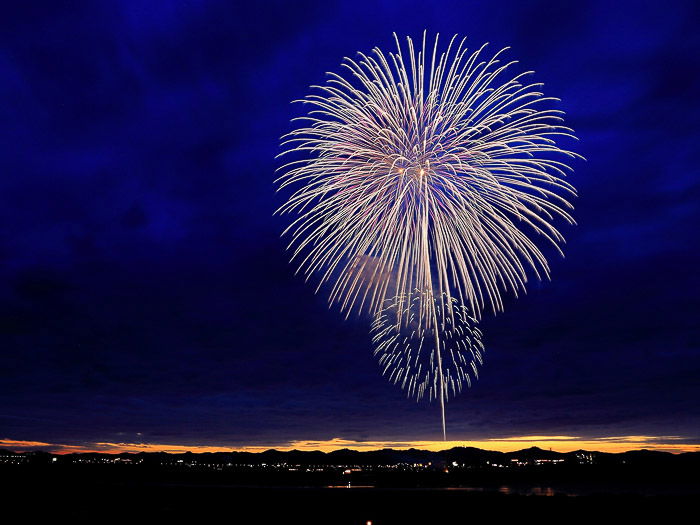
How to Post-Process Your Fireworks Photography
Shooting in RAW gives you complete control over the way the final photograph looks.
We recommend using Photoshop or Lightroom, but you can use other photo editing software, of course.
When editing fireworks, it is important to preserve the details of the scene. To bring out the texture of the lights, you should adjust clarity and contrast.
To emphasize the luminance of the light, you can also tweak highlights and shadows.
Pulling the highlights down can be beneficial to minimise the smoke created by the fireworks.
Bring out the colors by tweaking the saturation and vibrance. Watch any surrounding landscape for odd hues—saturation is very easy to overdo.
You can also try new compositions during post-processing. Create a panoramic image and merge them into one image to include fireworks shot at different times. This is going to make your images look more crowded and colorful.
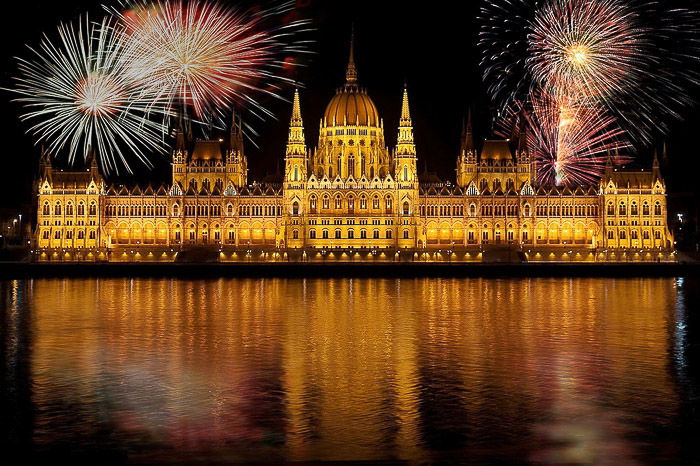
Conclusion
Photographing a fireworks display is a difficult but fun challenge to try.
No matter if it’s the Fourth of July or some other occasion, make sure to keep in mind our fireworks photography tips! You’ll be able to capture fireworks shots that are as dazzling as the actual show.
Use the biggest benefits of digital photography, and check the sharpness, the exposure and the composition regularly. Don’t check every shot. You’ll take your eyes off the sky and miss another opportunity. But check back every so often.
Fireworks shows tend to last long enough to give photographers plenty of chances to capture great shots with some variety. This time will also help you to set the aperture and exposure times correctly.
Write a checklist, and don’t forget to take your cable release with you!
